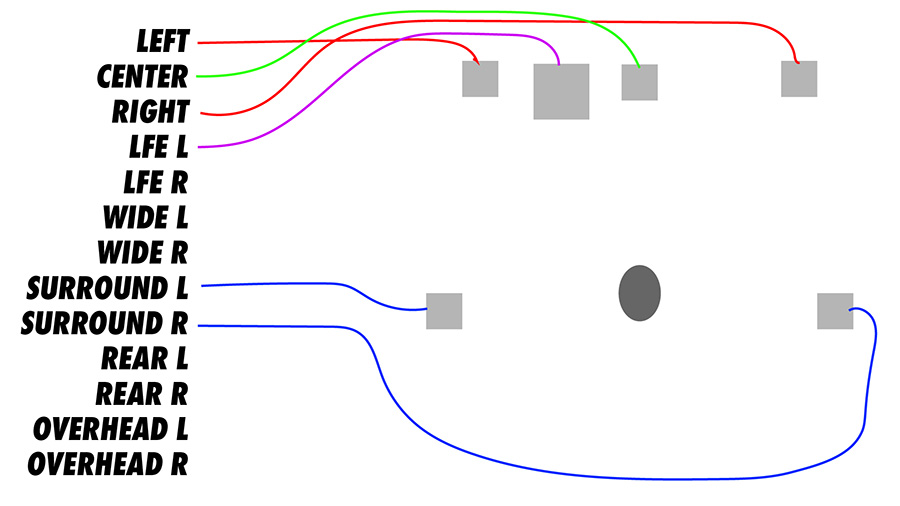Surround sound systems continue to evolve so quickly that all of the different configurations can be difficult to keep track of! 3.1, 5.1, 9.1.2… Dolby Atmos! By the end of this post, you’ll understand what all of that means and how to determine the optimal setup for your space.
Surround Sound Formats (5.1 vs 7.1 vs Stereo)
You’ve probably encountered numbers like 5.1, 7.1.2 and so on… These numbers indicate the number of audio channels in a surround sound speaker system.

Primary Channels
The first number represents the number of primary channels. The left and right channels, the center channel, the surround channels, and the wide and rear channels are all considered primary channels.
One of the most basic configurations is 2-channel stereo. A 2-channel stereo system consists of a left channel and a right channel. For the best results, the listener should sit to form an equilateral triangle between the speakers and the listening position.

By sending a different signal to each speaker in a stereo setup, sounds can appear to come from anywhere between the speakers. This is usually done by sending more signal level to one speaker than the other. As you add more primary speakers, the “canvas” is expanded, so that sounds can appear to originate from all around you on a horizontal plane.
Low-Frequency Effects Channels (LFE)
The second number indicates the number of LFE (or Low Frequency Effects) channels.
It’s important to understand that these numbers represent the number of channels, not necessarily the number of speakers. While the left and right signals could be sent to a subwoofer in a 2-channel stereo system, a 2.1 system sends a dedicated signal to the subwoofer.
Just knowing what the first two numbers indicate, you’re already equipped to understand most surround formats. In a 2.1 setup, all of the full range sound comes from the left and right speakers and the low frequency effects go to the subwoofer.

With a 3.1 configuration, we add a center channel. The center channel is probably the most important speaker for film sound, because mostly all of the dialog will come from the center channel.

Another common format is 5.1, where we have LCR channels (or left, center, right), two additional surround channels, and an LFE channel.

As the number of primary channels increases, the listener’s ability to more precisely localize sounds will improve.
You can even add an additional LFE channel for stereo subwoofers or so that one sub can provide low frequency effects while the other sub extends the frequency range of signals sent to the primary channels.
Low frequencies are more difficult for humans to localize because of their wavelength, though. So, you’ll generally hear a bigger improvement by adding primary channels rather than additional LFE channels.
Overhead Channels
The third number tells us how many overhead channels are in the system. Overhead channels allow the listener to hear sounds from above, extending beyond just the horizontal plane.
In a 9.2.2 system, there are nine primary channels, two LFE channels, and two overhead channels.

The overhead channels can be played through speakers placed above the listener, such as a pair of in-ceiling speakers. Alternatively, the overhead channels can play through floor standing for bookshelf speakers with up firing drivers. In this case, the sound would reflect off of the ceiling and back down to the listener.
Dolby Atmos vs 7.1 Surround Sound
Just when you thought you were starting to understand all of the possible surround configurations, Dolby Atmos shows up…
To understand Dolby Atmos, let’s quickly take a look at how film audio is mixed for surround. With a traditional channel-based mix, the audio team places each sound source with panning. For a 2-channel stereo system, this means using a pan knob to determine how the signal is divided between the two speakers. In a channel-based surround format, a joystick is commonly used.
So long as the mixing engineer and the end listener adhere to the same speaker placement standards, the sounds should appear to come from the same direction.
Dolby Atmos changes the paradigm from channel-based mixing to object-based mixing. Rather than routing the sirens to the left and the helicopter to the right, the engineer places each source in a virtual 3D space. Each sound source is an object and will be placed in the same spot when played back through any Dolby Atmos system, regardless of the physical configuration!
Source Media, Cables, & Speaker Placement
This is actually an important point to grasp… Some music, film, and TV is mixed for surround and others aren’t. And while protocols and algorithms exist to “upmix” or “downmix” from one format to another, the best experiences come from native surround content.
It’s also important to maintain surround compatibility throughout the signal chain. Connections like HDMI and optical are capable of transmitting discrete surround channels, while stereo RCA connections only support stereo.
The most important thing is to make sure the listening position and speaker placements adhere to the standards. I’m offering a free guide to help you place your speakers for the optimal experience. Download the guide here: Speaker Placement Guide
